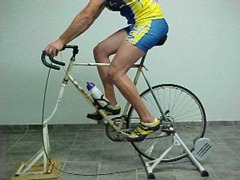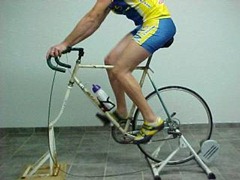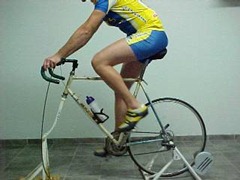Anatomical & Mechanical Analysis of Cycling
Posted on August 28th, 2011 by Andries Lodder
by Andries Lodder
My major objectives are to analyze the movements of cycling and the major muscles involved, and the contribution towards achieving the most successful and effective results during exercise.
Simple Classification
The Primary Purpose for this movement is speed and distance. Speed is a major factor, for the purpose is to complete the route or course in the shortest amount of time. Distance is just as important for cycling, for the longer the route, the better the endurance of the athlete has to be.5
The Movement of Phases can be classified as a Cyclical skill, due to the fact that it is continuous in nature, or done in an repetitive manner. One movement flows immediately into the next. Therefore classified in two phases: Propulsion phase and Recovery phase. When looking at the two phases simultaneously (pp. 2-3), there can be seen that no. 1 and no. 6 are almost identical, just the opposite. Where in no. 1 the left leg is in the propulsion phase and the right leg is in recovery phase, so in no. 6 the right leg is in the propulsion phase and the left leg is in recovery phase. Therefore the rest can be associated in the same manner. The Propulsion phase is initiated from photo 1 through to photo 5, therefore from Top Dead Centre to Bottom Dead Centre. The Recovery phase then commences from photo 6 through to photo 10, from Bottom Dead Centre to Top Dead Centre, completing 1 full rotation of a pedal stroke. 2, 5
During the Classification of the Skill an erect posture is not maintained, more in a crouched position. This is also a means of movement for exercise and fitness. Motion is given to one’s own body through locomotion on wheels (supported by the ground). Impact is received from one’s own body, in this case the lower extremities.5, 8
In the Simultaneous-Sequential Nature of Motion one could detect that it is more of a combination of the two. In the Sequential continuum maximum speed is extremely vital over long periods of time. In the Simultaneous continuum it is more of a push-pull movement, movement is directed along a straight line.5
Propulsion Phase





Recovery Phase





Anatomical Analysis
Propulsion Phase
![clip_image002[5]](https://www.bio4me.co.za/images/stories/clip_image0025_thumb.jpg)
![clip_image004[5]](https://www.bio4me.co.za/images/stories/clip_image0045_thumb.jpg)
![clip_image006[5]](https://www.bio4me.co.za/images/stories/clip_image0065_thumb.jpg)
Ankle – Dorsiflexed Knee – Extended Hip – Extended
Vastus Mediali
Vastus Lateralis
Rectus Femoris
Gluteus Medius
Table adapted from 1,2 & 5 | Photographs from 9
Recovery Phase
![clip_image002[7]](https://www.bio4me.co.za/images/stories/clip_image0027_thumb.jpg)
![clip_image004[7]](https://www.bio4me.co.za/images/stories/clip_image0047_thumb.jpg)
![clip_image006[7]](https://www.bio4me.co.za/images/stories/clip_image0067_thumb.jpg)
Ankle – Plantar Knee – Flexed Hip – Flexed
Table adapted from 1,2 & 5 | Photographs from 9
Mechanical Analysis
Introduction to Mechanical Analysis
The mechanical Analysis of human performance involves the identification of laws and principles that help explain the most appropriate form for the execution of the activity and identify the mechanical reasoning for success or failure.5 To explain the mechanical factors that contribute most to performance, it is necessary to look at the underlying objectives of cycling in motion:5
- Balance, to attain mobility
- Locomotion, to travel a prescribed distance
- Projection, for optimum speed and accuracy
- Manipulation, to reproduce a pattern
- Maximum effort, for maximum speed, power and force
Each of these underlying mechanical objectives requires consideration of different but overlapping sets of mechanical factors.Forces involved in mechanical analysis are always as follows:5
- Weight – interactions between the mass of body and the position of the center of gravity.
- Momentum – the ability to stay in motion.· Normal reaction – interactions between the body and the object (bicycle).
- Friction – force that opposes efforts to slide or role one body over another.
- Drag – resistance to forward motion experienced by objects moving through, in this case, air.
- Lift – result of changes in air pressure as the result of differences in airflow velocities. Lift is perpendicular to drag flow.
- Buoyancy – the upward force counter balancing the weight of the body, acting vertically downward at the center of gravity, in water.
Forces Involved During Cycling
Weight: During cycling, force is proportional to the slope and total weight of the bicycle and the rider. Therefore, the greater the slope and the larger the combined weight, the larger the force of gravity will be.1
Momentum:During momentum, inertia forces are present. The retarding of acceleration and deceleration is proportional to the total mass and the rate of acceleration. Therefore, retarding acceleration and increasing rolling resistance. In other words, for a rapid increase in speed, mass in a whole has to be decreased.Also occurring, is energy loss during braking, wasting kinetic energy of motion. Unfortunately, this energy can’t be recovered in any simple fashion.2
Normal reaction: For improvement, resulting in conservation of energy due to less body movement on the bicycle, can be the result of correct posture on the bicycle, improving pelvic stability, balance and co-ordination. Together with stability is drafting during cycling, the closer the rider sits on the leaders wheel, the more energy he saves. Up to 35% conservation of energy as when cycling alone.1
Friction: Can be devided into correct pedaling motion and rolling resistance.Rolling resistance – To do with the tires on an particular surface. For a decrease in rolling resistance, inclusion of smoother and harder road surfaces, high tire pressure, narrow tires and less weight on tires. Energy lost when wheel, tire, surface do not spring back elastically and fails to return all of the energy to the bicycle. Therefore energy lost due to transfer of energy into heat energy. On rough roads, energy is lost to bouncing.1 Pedaling Motion – Linear reciprocating motion. Pedal in an ‘oval’ shape fashion. Push forward as far as possible by leading of the heel without tensing it, at the bottom of the stroke, the ankle is pointing slightly downwards, now make a scraping motion backwards. The shape of a stroke should feel basically oval. Therefore being efficient with your stroke and creating as much force possible, with the least amount of force and tension.8
![clip_image002[9]](https://www.bio4me.co.za/images/stories/clip_image0029_thumb.jpg)
![clip_image004[9]](https://www.bio4me.co.za/images/stories/clip_image0049_thumb.jpg)
![clip_image006[9]](https://www.bio4me.co.za/images/stories/clip_image0069_thumb.jpg)
![clip_image008[5]](https://www.bio4me.co.za/images/stories/clip_image0085_thumb.jpg)
Photographs from 7
Drag: This depends on a number of factors:3
- Cross-sectional area of the body perpendicular to the flow of air.
- Shape of the body.
- Smoothnes of the surface.
Aerodynamic drag also consists of 2 types of drag, skin friction drag and pressure drag. Skin Friction Drag – The friction force of the wind, the clothing that flutters (visual demonstrations). Pressure Drag – Contributes to the movement of the body and the shape of the bicycle. Air flows smoothly around a streamlined shape. Therefore Power is proportional to the product of drag force and velocity. Therefore an increase in speed asks for an increase power needed. Therefore a rider in an crouched position, decreases wind resistance. To change from riding with a rounded back to a flat back, rotate the pelvis forward on the saddle and lower your chin to fill the gap between your shoulders and arms. By improving the riders position on the bicycle, is the most efficient way to increase potential speed.4
Lift: It is the result of changes in air pressure as the result of differences in airflow velocities. Lift is perpendicular to drag flow.5
Buoyancy: Only applicable to activities taking place in aquatic environments. Therefore not applicable to cycling.5
Reference List:
- Edmund R. Burke. (1986). Science of Cycling. Copyright © 1986 by Edmund Burke.
- Edmund R. Burke, Mary M. Newsom. (1988). Medical and Scientific Aspects of Cycling Copyright © 1988 by Edmund R. Burke and Mary M. Newsom.
- James G. Hay. (1993).The Biomechanics of Sport Techniques (4th ed.) Copyright © 1993, 1985, 1978, 1973 by Prentice-Hall, Inc.
- Edmund R. Burke. (2002). Serious Cycling (2nd ed.). Copyright © 1995, 2002 by Edmund R. Burke.
- Nancy Hamilton, Kathryn Luttgens. (2002). Kinesiology: Scientific Basis of Human Motion(10th ed.). Copyright © 2002, 1997, 1992, 1982 by the McGraw-Hill Companies, Inc.
- Carla Z. Hinkle. (1997). Fundamentals of Anatomy and Movement: A Workbook and Guide Copyright © 1997 by Mosby-Year Book, Inc.
- Gerry Carr. (1997). Mechanics of Sport: A Practitioner’s Guide. Copyright © 1997 by Gerald A. Carr.
- Cycle Lab Academy. (1999). Lab Cycling ® Instructors Course Manual. Copyright © 1999 by Cycle Lab Academy.
- Photographic Evidence of Skill provided by own Digital Camera for the distinguishing between skill phases.
Tweet